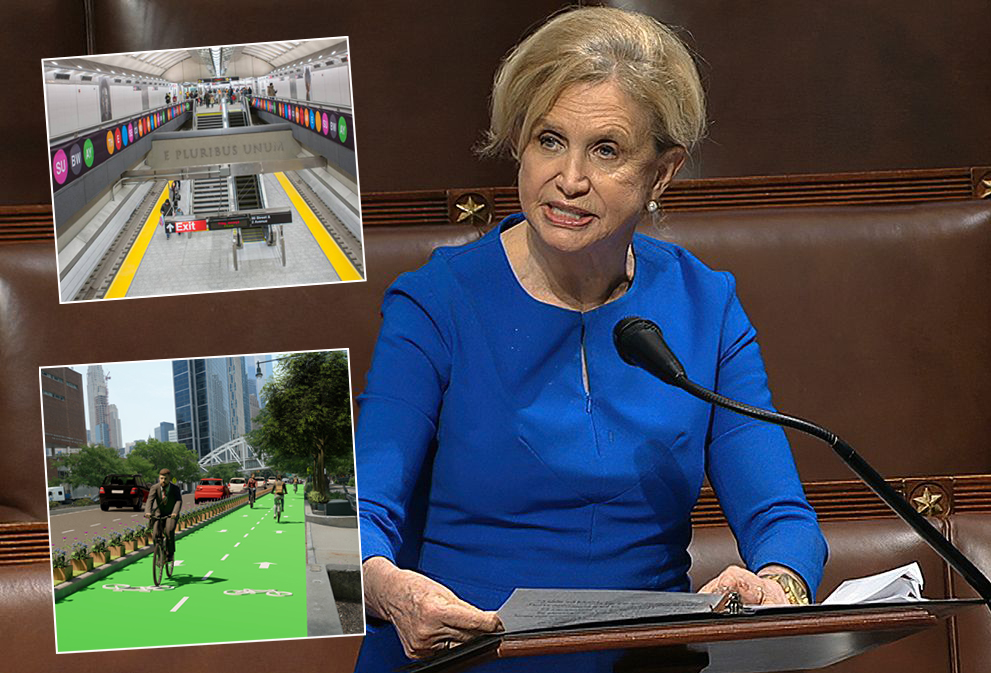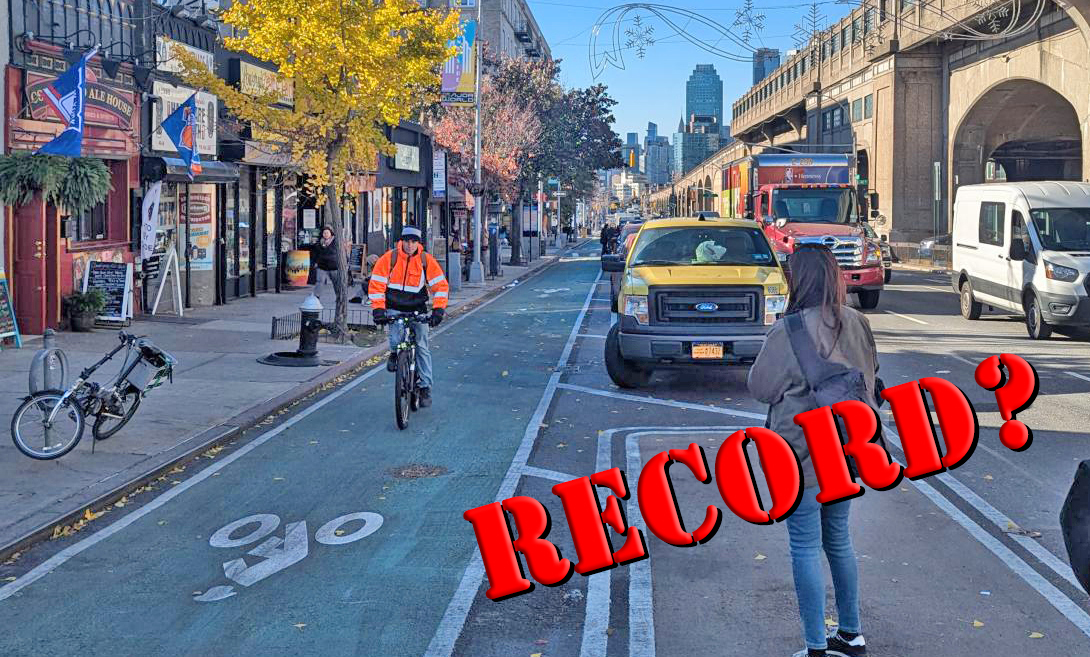Last week, 28-year-old Citi Bike rider Carling Mott was killed by a truck driver on E. 85th Street — the same roadway that Rep. Carolyn Maloney lobbied in 2016 to remain without a painted bike lane. Given Maloney's role in preventing a basic street safety improvement in her district, we reached out the campaigns of Maloney and her two challengers, Rep. Jerry Nadler and Suraj Patel, for opinion pieces about livable streets. Nadler declined. Patel's op-ed, which highlighted Maloney's lobbying, was published on Tuesday. Here is Maloney's, which does not mention last week's fatal crash.
In a crowded city, where pedestrians, bicycles, cars, buses and trucks compete for street access, it takes creative policies including infrastructure adaptations and pricing incentives to keep the city functioning at top efficiency.
Encouraging commuters to return to using mass transit as we emerge from the disruptions of the pandemic is the single most effective tool to ease the street clutter and congestion.
That is why I am so proud of the work I have done to build the Second Avenue subway, which despite all the naysayers, now carries 300,000 commuters a day and is poised, based on my successes in securing funding, to extend to 125th Street in East Harlem.
Above ground, easing the crush on city streets includes expansions of the MTA’s bus lane program, which speeds commuters’ travel time through congested corridors while slowing down car traffic in remaining lanes.
It requires federal, state and city agencies, including the MTA, to speed up enactment of the already-approved congestion pricing plan which will discourage car traffic below 59th Street while generating at least $15 billion a year towards the MTA’s critical capital improvement plan for subways. Effective mass transit minimizes the incentives to drive into the most congested parts of Manhattan, and that helps all of us breathe more easily.
And it includes support for, and expansion, of plans to increase the sense of safety on the rails.
I have introduced the Michelle Alyssa Go Act which would alter Medicaid rules that place a limit on the number of beds in mental health facilities to 16, an unreasonably low limit in a crowded city like New York where the lack of available beds contributors to the larger problem of mentally challenged people who have committed a disproportionate number of crimes on the subway that have led to the increased fear for riders.
Michelle Go was the young woman fatally pushed onto the subway tracks by a mentally ill man who told police he had tried repeatedly to get treatment in a mental health facility, but was driven to push a woman onto the tracks when there was no bed available.
In a related manner, I am particularly interested in a pilot program to install gates along platform edges in selected stations as a way to increase safety and deter the kind of incidents in which commuters have been pushed onto the tracks, too often with fatal results.
But it is not just cars and mass transit that requires close consideration for how to move people more efficiently around the city.
Bike lanes have proven an effective measure that combines safety for riders and vehicles by keeping them apart, while encouraging bicycle commuting that thousands of New Yorkers now take advantage of, weather permitting.
Just in the last several years, I have secured funding both through the appropriations process and the federal government's highway capital plan for a variety of transportation infrastructure projects in my current district, which include bike lanes in the planning.
These include $5.6 million for the Queens Plaza Redevelopment, $250,000 for the Long Island City Links Initiative improving the physical environment for pedestrians and bikers, a $1.56-million Federal Highway Administration grant for bike paths at the Hunters Point South Waterfront Park and nearly $750 million to build a new Kosciuszko Bridge, which includes a bike and pedestrian path.
I am also encouraged by the plan announced this week by Manhattan Borough President Mark Levine to revamp and expand the heavily used Hudson River Greenway bike- and pedestrian-path by widening it into one lane on the West Side Highway. Already the most heavily used bikeway in the city, and perhaps the country, it is exactly the kind of creative adaptive reuse of city streets we should be looking at to accommodate the disparate demands of the commuting public.
Those grants contribute to the development of bike lanes which involve more than just slapping down some paint, and incorporate protection to separate the lanes from car traffic, along with increased signage. Greater traffic enforcement is essential as well.
The open streets program which expanded so dramatically during the pandemic have shown themselves to be widely embraced in neighborhoods, as well as in tourist-heavy areas such as Times Square. I support Borough President Levine’s call to extend the pedestrian plaza further down Broadway, especially in the wake of a tourist being struck by a taxi in an outdoor cafe.
It is encouraging that Albany finally lifted state-imposed limits on their hours of operation for the city's speed cameras. Federal support can help in expanding the number of red-light cameras that slow car traffic and save the lives of pedestrians.
It is not my choice to run against my longtime friend and colleague Rep. Nadler in the 12th District I have long represented, but the [redistricting] Special Master had other ideas. So voters are forced to make a choice and I believe I am the better choice.
This is especially true because of the recent egregious Supreme Court decisions overturning Roe v. Wade, gutting New York’s century-old gun licensing law and limiting the government’s ability to tackle climate change by enforcing clean air and water rules. In essence, the Supreme Court is regulating women’s control of their bodies while deregulating gun laws, which is precisely the opposite of what should be done.
But I have an unparalleled record of accomplishments, including bringing more than $10 billion in federal funding to my district for housing, health centers and infrastructure projects such as those mentioned above that can help ease congestion and improve safety on the crowded streets of our crowded city.
That is why government watchdogs have consistently rated me in the top three on lists of most effective members of Congress, far above my 10th district colleague, while we rate comparably on lists of most progressive congressmembers.
I love this city and public service is my life’s calling, ever since I was called upon by fellow teachers to fight to save funding for the East Harlem ESL program where I taught.
As your representative in Congress, I will continue to support, and deliver funding for, creative solutions to expand and improve our public transit, increase safety for pedestrians and bikes, and decrease traffic congestion.
Fighting to improve the lives of my constituents is what I do, and what I will continue to do for the betterment of my city and country.
Carolyn Maloney has represented the Upper East Side in Congress since January, 1992.






